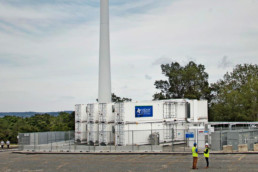New Innovative Insurance Instruments Will Accelerate Project Development And Deployment For TRI Biorefineries
BALTIMORE, Jan. 29, 2019 /PRNewswire/ — ThermoChem Recovery International, Inc. (TRI), the Baltimore-based gasification technology company at the forefront of commercializing biorefineries, is pleased to announce that it has signed a memorandum of understanding (MOU) with New Energy Risk (NER) that can help accelerate project development, increase profitability, and provide certainty of execution.
After completing due diligence on TRI’s suite of biorefinery-enabling technologies, NER, a leading provider of performance risk solutions for breakthrough technologies and affiliate of global insurance company, AXA XL, is prepared to provide various insurance solutions to biorefinery owners and projects which utilize TRI’s equipment and technology.
TRI has named New Energy Risk and AXA XL as its preferred supplier of technology performance insurance for TRI customers and projects.
“With NER taking the lead on providing solid insurance options to owners using our technology, we have eliminated a key obstacle to making commercial-scale biorefineries profitable and replicable,” said Dan Burciaga, President and CEO of TRI. “NER studied TRI’s 20-year track record of accomplishments and recognized a great opportunity to help make our projects more bankable. This is a great development for us, and for the whole industry.”
TRI is a leading provider of steam reforming gasification systems suitable for Municipal Solid Waste (MSW), woody biomass, agricultural residues and other waste feedstocks. Its systems have been selected for and deployed on various commercial North American projects including the Fulcrum Bioenergy Project Sierra Biorefinery in Nevada and Norampac black liquor gasification, a division of Cascades Paper. Additionally, TRI’s multi-feedstock, fully-integrated biorefinery in Durham, North Carolina has run for over 13,000 hours, successfully producing syngas that is particularly well-suited to generating Fischer-Tropsch liquids and upgrading to ASTM-certified fuels.
Burciaga said, “New Energy Risk understands this sector, and they understand our technology. What’s more, they know the types and levels of risk mitigation our project owners and investors need in order to get these projects over the finish line and to get steel into the ground.”
“Our business is in backing technologies with demonstrated reliability,” said Jon Cozens, Chief Commercial Officer at New Energy Risk. “We find the rigor to which TRI has developed and proven its technology to be one of the most thorough we’ve found, and over the last several years TRI has been associated with many of the highest quality projects New Energy Risk vetted. We look forward to accelerating the deployment of the TRI technology and providing assurance to owners and investors that the TRI technology will perform.”
About TRI
Founded in 1996 and headquartered in Baltimore, Maryland, TRI is a global leader in steam reforming, an ultra-clean and high-efficiency gasification technology well-suited to a range of biorefinery and power generation applications. TRI’s proprietary process converts cellulosic feedstocks (including post-sorted Municipal Solid Waste (MSW), bark, forest residuals, agricultural waste, energy crops and low rank coals) into a synthesis gas (“syngas”) which can be converted into biofuels, biochemicals and power. TRI partners with world-class technology and EPC providers and licenses its proprietary technologies — including feeder, gasification and gas clean-up systems — as well as provides specialized equipment and engineering services to the global renewable energy sector.
About steam reforming gasification Steam-reforming gasification is the first stage in the biomass-to-liquids process that converts woody biomass and other solid feedstocks into premium fuels. Gasifiers convert carbon-containing materials into carbon monoxide, hydrogen and carbon dioxide. This is achieved by reacting the material at medium temperatures (>700 °C), without combustion, with a controlled amount of oxygen and/or steam. The syngas is then cleaned and the carbon monoxide to hydrogen ratio adjusted if necessary to meet the specifications needed for input to chemical catalytic reactors, for example the Fischer-Tropsch (FT) process.
http://tri-inc.net/steam-reforming-gasification/
About New Energy Risk
New Energy Risk is a provider of performance risk solutions for breakthrough technologies and pioneer in the development of large-scale technology performance insurance. The company was founded in 2010 to provide complex risk assessment and serve as an effective bridge between technology innovators and insurers. Since then, New Energy Risk has helped its customers gain over $1 billion in financing for renewable energy and new technology deployments. To learn more, visit www.newenergyrisk.com.
About AXA XL
AXA XL provides insurance and risk management products and services for mid-sized companies through to large multinationals, and reinsurance solutions to insurance companies globally. We partner with those who move the world forward. To learn more, visit www.axaxl.com
Source provided by: ThermoChem Recovery International, Inc. (TRI) Jan 29, 2019, 07:00 ET
More Money Flows to Flow Batteries: ESS Nabs $13 Million Funding Round
More Money Flows to Flow Batteries: ESS Nabs $13 Million Funding Round
The company wants to expand its annual iron flow battery production to 900 megawatt-hours.
Iron flow battery maker ESS raised $13 million in a Series B round, expanding the pool of cash available to upstart alternative storage companies.
The money will go to automate and expand the manufacturing facilities where the Oregon company makes its containerized long-duration storage product, the Energy Warehouse. If all goes according to plan, the improvements will raise the six-year-old company’s annual output to 900 megawatt-hours.
That’s significant for the small field of long-duration contenders challenging lithium-ion’s dominance in the energy industry today.
Flow battery makers like ESS tout the relative safety of their ingredients compared to lithium-ion, with its flammability and rare earth metals. The alternative chemistries also provide long-duration storage, maintaining high levels of discharge well beyond the 4-hour mark typical of lithium-ion systems today.
The challenge is that little market opportunity exists for 8 hours of storage, and customers and investors tend to be leery of a technology that’s even newer and more exotic than the mainstream batteries.
The new round of funding suggests that at least some investors are changing their minds.
The Series B brought back original investors, including Pangaea Ventures. But it also welcomed new investors global chemical company BASF, Cycle Capital Management, Presidio Partners Investment Management and InfraPartners Management.
“After conducting extensive research across a range of battery technologies, designs and developers, we’ve concluded that ESS offers a superior combination of low-cost, clean, safe and long-life chemistry; scalable architecture, and management experience,” BASF Venture Capital Managing Director Markus Solibieda said in a statement.
ESS closed its Series A in October 2015, raising $3.2 million from Pangaea Ventures, Element 8 and other angel investors. At that time, the company had also been awarded roughly $4.5 million in grants from ARPA-E, the Oregon Nanoscience and Microtechnologies Institute, and Oregon Best.
This summer, VP of Business Development Bill Sproull told GTM that the near-term strategy is to use demonstration projects to raise awareness about the technology, and to work with EPCs and project developers to get units in the field around the world.
But, Sproull said, ESS is already getting revenue from its demo projects. “We have not had to donate systems to anyone,” he said.
Flow batteries more broadly have made some headway over the past several months.
NEXTracker, a leading solar tracker vendor, recently relaunched its flow battery product and confirmed that it had deployed some units, without saying how much capacity.
Vanadium redox flow battery maker Vionx launched a third-party performance insurance product backed by New Energy Risk. This offering reduces the trust barrier for customers — instead of relying on a young company with a miniscule balance sheet to back a 20-year product, the burden shifts to an established insurer. ViZn Energy similarly developed a third-party insurance product.
Flow battery contender Primus Power secured a $32 million equity raise in April to fund global expansion to Europe, China and South Africa. That brought total equity funding to $94 million, plus another $20 million in government grants.
Originally published at www.greentechmedia.com.
I Don’t Like Losses, Sport
We have news you can use today on the subject of the most powerful, inevitable, fearsome, mysterious, taboo, and untouchable four-letter word in the advanced bioeconomy lexicon.
Risk.
The problem of Investor risk is ridiculously easy to understand and ridiculously hard to solve. If you think back to your own 401(k) or IRA for a second, you’ll understand risk tolerance among financial investors in a jiffy.
Financial investors will tolerate very short-term cases of marginally sub-par returns and they have no tolerance at all of losses.
As Michael Douglas, in his Oscar-winning turn as Gordon Gekko in Wall Street, elegantly explained it:
“I don’t like losses, sport. Nothing ruins my day more than losses. Now you do good, you get perks, lots and lots of perks.”
The poor distribution of technology risk is a market failure, especially corrosive in the bioeconomy because risk concentrates like a hurricane and blows down those least able to bear it, like a bully picking out a mark on the playground.
And risk induces panic and suffocation long before it induces death, which is one reason why the Valley of Death is so unimaginably painful to ventures and the people in them. Chilling early-stage venture investing far more effectively and absolutely than the absence of good deal flow.
What’s to protect the bondholders? The technology risk insurance program.
The remedy
Recently, Fulcrum BioEnergy raised $150 million in bond financing for its Sierra BioFuels project, which will convert up to 175,000 tons of municipal solid waste per year into more than 10 million gallons of low-carbon synthetic crude oil, beginning in early 2020. More on Fulcrum’s progress here — and our most recent Multi-Slide Guide is here.
Fulcrum’s existing investors include US Renewables Group, Rustic Canyon Partners, United Airlines, Waste Management, BP, and Cathay Pacific. Their strategic equity capital is at risk — as it should be.
“There’s a lot that’s special about the Fulcrum project,” New Energy Rick CEO Tom Dickson told The Digest. “They have Abengoa as an EPC, and despite what has happened to the corporate paren, Abengoa’s core US EPC unit is strong. They have offtake, great management, irreplaceable equity partners. But it’s not GE standing behind a technology with a performance agreement. There’s a perceived technology risk.
So, who’s measuring that risk in order to efficiently spread it. Turns out, not many.
“Each party has a focus on the risk they have a mandate to assume,” Dickson noted. “Lenders have a mandate to take credit risk, and some market risk. But they are not really into assuming technology risk. Because of that, when it comes to the technology process risk, they are not trying to understand that, and someone has to do that to get first commercials financed, and put capital behind that assessment.”
How’d that “first of kind” project get done? For one thing, Fulcrum brought in New Energy Risk, an affiliate of global insurance giant XL Catlin.
New Energy Risk is a specialty insurance technology company that acts as an effective bridge between new technology innovators, insurers and lenders. It was founded in 2010 to provide complex risk assessment and is part of XL Innovate, an insurance technology venture firm. It’s not a small potatoes thing. The firm has helped its customers gain over $1 billion in financing for renewable energy and new technology deployments.
In this case, New Energy Risk developed a custom solution, backed and provided by XL Catlin (the global brand used by XL Group Ltd’s insurance and reinsurance companies which provide property, casualty, professional and specialty products around the world).
What happened?
“We start with the engineering data,” explained NER’s Jon Cozens, “ and we end up with actuarial output. From the engineering data we are creating a model and looking at failure modes, and the impact on financing and the risk position. In the event of a failure, we ask, how long will it take to alleviate, is the capital there to handle it, and could the timelines impact loan covenants.
“We step in when there is underperformance,” Dickson added, “when the project has run out of alternative means — warranties, it’s own cash — and the failure is due to the technology. Not because of a hurricane, but because of the science; you turn it on, it doesn’t work or at a low percentage of nameplate and because of that , in default of a loan covenant. We alleviate that shortfall.”
Every financing is different
Sometimes the risk freak-out factor focuses on long-term performance, sometimes around start-up and commissioning.
To complicate matters, every project is so darn different. It’s not as simple as: here’s a wind turbine, here’s the standard power purchase agreement, here are the wind curves. The feedstocks are different, the molecules vary, the technologies are unique, the offtake agreements are one-offs, the lenders are not the same, some bonds are rated and others are not, the loan periods don’t line up, the covenants change with every deal.
Dickson explains, “it depends on the policy. if it is short term and responding to risk around completion and commissioning, for us we’re looking really at moving stuff through the pipes, and what are the failure modes, and how do you recover from those. Does it mean adding a unit or redesigning — and does the project have enough time to fix it?”
“In a 10 year policy where we are looking at failure at any time during amortization when it falls below X. By then, the pipes have been figured out, and it is about long-term science, and becomes more about reliability than the expected efficiency. Also, we do work, actively with the USDA loan guarantee program. 9003 loan guarantees require an EPC wrap, and while a lot of EPCs do will wrap completion and delay, it’s been tough relating to the technology itself. Some are successful, some get there some do not. We’ve been working in that area as well.”
So, it’s complex and time consuming.
“It can take 3–4 months for our work,” Dickson noted. “But we’re never the long pole in the tent when it comes to timelines.”
The best projects survive
“If we can structure around the risk,” Cozens told the Digest. “There are going to be fewer failures and more successes. But we want to help the strong projects and keep the projects not yet ready on the back burner. Even if we structured our way out of a loss [from a single project], we all need to grow the capital base, and that means not just doing projects for the sake of it and making money for ourselves, but identifying and supporting the best projects.”
And Fulcrum fits that mould. As Dickson eplained, “Fulcrum is showing what is possible in the waste-to-fuel space, and doing it at unprecedented scale. We look forward to working with them on more projects in the years to come.”
Best of breed, multiple projects. Terms that were in the “future milestones” part of a corporate slide desk, say, five years ago. Today, we’re seeing the survivors from a culled flock beginning the breakout from the Valley of Death.
As Cozens noted, “The winners in the market are survivors and for a reason,”
Originally published at www.biofuelsdigest.com on December 11, 2017.
Vionx Secures Insurance Product for Its Flow Batteries
Vionx Secures Insurance Product for Its Flow Batteries
The product adds a bigger balance sheet to the performance guarantee, potentially de-risking investments in vanadium redox flow batteries.
Flow battery maker Vionx took a step toward easier sales by releasing an insurance product for its technology.
The Massachusetts company teamed up with New Energy Risk to create a performance insurance policy that covers energy, power, round-trip efficiency and availability of the vanadium redox flow systems. This could open a new chapter in the bankability of insurgent battery technologies challenging lithium-ion’s dominance.
Flow battery makers argue that their long-duration systems can cycle for years without degradation, making them ultimately cheaper to own than lithium-ion batteries, which fade over time. The lifetime cost of ownership argument, though, requires the customer to believe the company’s claims about its new technology, even though it hasn’t been operating for more than a few years.
Having an outside entity vet the technology changes the dynamic of trust. Vionx asserts that this is the first insurance product for a utility-scale flow battery.
“It takes Vionx from, ‘We can compete on price; trust us,’ to ‘We can compete on price, but you don’t have to trust us, because it’s guaranteed by an insurance company,'” said Daniel Finn-Foley, an energy storage analyst at GTM Research.
Besides confidence in the technology, the end customer needs to feel secure that if something does go wrong, someone’s on the hook to fix it.
Performance guarantees have become standard for long-term lithium-ion storage contracts with major utilities, Finn-Foley noted. Recent utility-scale projects in California included 20-year performance warranties, which means the developer will absorb the cost of replacing batteries and inverters as they give out.
That’s a credible commitment from a company like AES, which has been building storage systems for a decade and has a market cap of $7.3 billion.
It’s a lot harder to convince customers when a company has only been around for a few years and has delivered just a few small pilot-scale projects. The insurance offering shifts the ultimate burden of accountability from Vionx to New Energy Risk, an affiliate of global insurance company XL Catlin.
The customer for the policy would be the engineering, procurement and construction contractor that purchases Vionx batteries as part of an energy storage project. If any issues arise with a deployed system, Vionx still has the affirmative obligation to repair or replace according to warranty. The insurance covers the scenario in which there’s a performance shortfall and Vionx can’t fulfill the warranty.
“Vionx is a small company, but you have this financial support if anything does go wrong,” said Alan Dash, a member of the Vionx board.
Phrased differently, this means that New Energy Risk (NER) has sufficient confidence in Vionx’s flow systems to put its name and money behind them.
Under the arrangement, NER is offering an initial tranche of $50 million of coverage for Vionx’s current pipeline.
“We are prepared to provide additional capacity as Vionx grows and customer adoption increases in the marketplace,” said NER CEO Tom Dickson.
The insurer’s confidence stems from a nearly 20-month vetting process. The NER analysts took a deeply technical approach, crunching through raw performance data from field units and accelerated lifetime testing, said Chief Commercial Officer Jon Cozens.
The company specializes in seeking out promising emerging energy technologies from companies with limited balance sheets, and offering them creditworthy support, Cozens said.
“In the energy finance construct, a lot of times lenders require balance-sheet support to finance the deal,” Cozens said. “Our business is fundamentally around enabling project finance.”
This boost comes at a pivotal time for Vionx, which is looking to expand from its first few demos to broader commercial production.
The company has two systems operating today in Massachusetts: a 160-kilowatt, 4-hour system at an Army Reserve base at Fort Devens, and a 500-kilowatt, 6-hour system at Holy Name High School in Worcester. Vionx has built partnerships with other veteran companies to help move the product, including UTC, Siemens and 3M.
I was able to track down one other flow battery insurance product. ViZn Energy has developed an insurance product that it is actively sharing with specific customers in three-way meetings with insurance providers, VP of Marketing Mike Grunow confirmed in an email.
In fairness to Vionx, ViZn has not broadcast this information, and insurance has not been needed on its announced bookings so far. The trophy for first flow battery insurance sold, then, remains up for grabs.
– – –
Read the article on GreenTechMedia
$500M in Renewable Energy Projects
Insurtech company hires Chief Science Officer to deepen scientific expertise of emerging energy-related technologies
MENLO PARK CALIF – “Today, New Energy Risk, a global pioneer in creating insurance policies for renewable, high-efficiency energy developers and new technology producers, announced that its customers have secured a total of $500M in financing to support such energy projects.
Since its founding, New Energy Risk has underwritten production insurance for over $250 million in financing for fuel cell and waste-to-energy projects, including a 65MW Bloom Energy deployment. An additional $250 million is set to deploy this year, ranging from biomass to solar to energy storage. Using its modeling technology, New Energy Risk is fundamentally improving the economics behind alternative energy deployments, making them more cost competitive and providing certainty of output for customers, owners, and financiers.
Transitioning a new technology from science (proving the fundamentals) to engineering (implementing it in the field) can be expensive, time consuming, and complicated. This transition comes with high technical risk, and such risks have made it difficult for renewable energy projects to gain access to favorable financing terms. However, an insurance policy that guarantees output would significantly reduce the risk for buyers and funders, who otherwise want to adopt and support sustainable practices. Such policies did not exist, until now.
New Energy Risk offers customized insurance solutions for large-scale energy projects by accurately quantifying the risks and uncertainty associated with renewable energy projects for the very first time. This allows insurers to underwrite such projects, unlocking lower interest rates and energy costs over the long term. New Energy Risk’s unique offering lies in its algorithmic approach: a techno-economic risk model that combines analytics around scientific validity, engineering feasibility, project financials, and actuarial science.
New Energy Risk is led by experts in actuarial science, energy technologies, engineering, and financial modeling. In order to continue deepening its scientific understanding of new renewable energy technologies, the company has added Dr. Brentan Alexander, an expert in waste-to-energy processes, thermochemistry, and electrochemistry, as the firm’s Chief Science Officer. Dr. Alexander is a graduate of MIT and Stanford, serial entrepreneur, and leading researcher in the field of the clean conversion of carbon-based fuels. New Energy Risk has also promoted Jon Cozens, its Managing Director, to Chief Commercial Officer, to add focus on the company’s business development, partnerships, and transaction execution.
“We are thrilled to be working with incredible partners such as XL Catlin and a panel of leading global reinsurers, as well as cutting-edge renewable energy companies from around the world. Together, we have promoted over $500 million worth of large-scale energy deployments and we are experiencing unprecedented interest from customers seeking to deploy new forms of clean energy. In response, we have grown our team, both in size and expertise, with the addition of Dr. Alexander as Chief Science Officer and the expansion of Jon Cozens’ role as Chief Commercial Officer,” said Tom Dickson, CEO of New Energy Risk.
“New Energy Risk is the only dedicated, reliable source of performance analysis and underwriting for renewable energy and industrial biomass projects,” said John May, Managing Director at leading investment firm, Stern Brothers & Co., and Co-Head of the its Cleantech Energy and Infrastructure Group. “Their expertise and capacity for performance insurance is a key ingredient in successfully financing large deployments around the world. We look forward to continue working with them to accelerate the adoption of these new energy technologies.”
About New Energy Risk
New Energy Risk is a provider of innovative data analytics and financial risk transfer solutions to the renewable energy industry worldwide. It was founded in 2011 to serve as a risk assessor and intermediary between clean-energy innovators and insurers.




